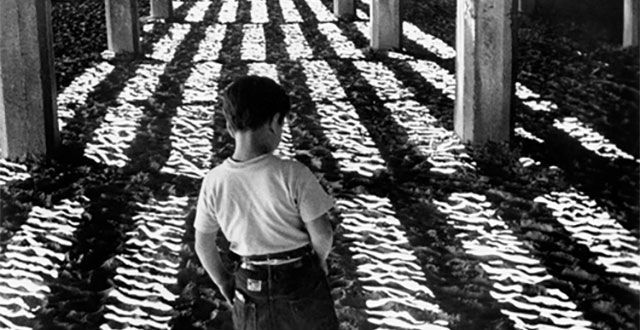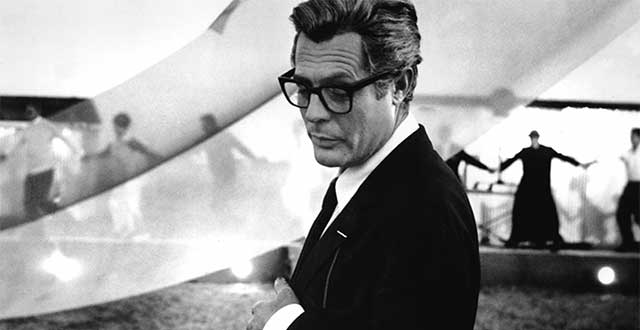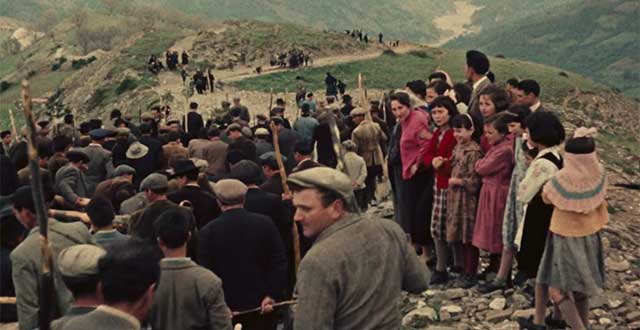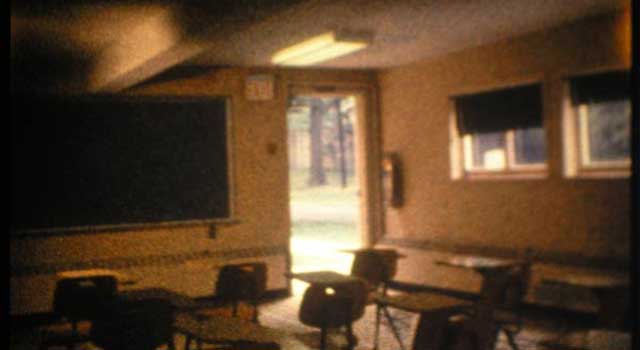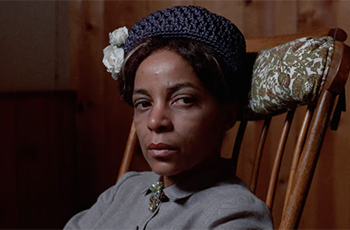EXT. 8TH STREET—LATE AFTERNOON (C. 1959).
CAMERA IN NONSTOP MOTION is on the shoulder of a young man, late teens, intently walking west on a busy Greenwich Village thoroughfare.
Under one arm, he’s carrying books. In his other hand, a copy of The Village Voice.
He walks quickly, past men in coats and hats, women with scarves over their heads pushing collapsible shopping carts, couples holding hands, and poets and hustlers and musicians and winos, past drugstores, liquor stores, delis, apartment buildings.
But the young man is zeroed in on one thing: the marquee of the Art Theatre, which is playing John Cassavetes’s Shadows and Claude Chabrol’s Les Cousins.
He makes a mental note and then crosses Fifth Avenue and keeps walking west, past bookstores and record shops and recording studios and shoe stores, until he gets to the 8th Street Playhouse: The Cranes Are Flying and Hiroshima Mon Amour, and Jean-Luc Godard’s Breathless is coming soon!
We stay on him as he turns left on Sixth Avenue and hustles his way past diners and more liquor stores and newsstands and a cigar store and crosses the street to get a good look at the Waverly marquee—Ashes and Diamonds.
He cuts back east on West 4th past Kettle of Fish and Judson Memorial Church on Washington Square South, where a man in a threadbare suit is handing out leaflets: Anita Ekberg in furs, and La Dolce Vita is opening at a legitimate theater on Broadway, with reserved seats for sale at Broadway ticket prices!
He walks down LaGuardia Place to Bleecker, past the Village Gate and the Bitter End to the Bleecker Street Cinema, which is showing Through a Glass Darkly, Shoot the Piano Player, and Love at Twenty—and La Notte is held over for a third straight month!
He gets in line for the Truffaut movie and opens his copy of the Voice to the Film section and a cornucopia of riches jumps from the pages and swirls around him—Winter Light . . . Pickpocket . . . The Third Lover . . . The Hand in the Trap . . . Andy Warhol screenings . . . Pigs and Battleships . . . Kenneth Anger and Stan Brakhage at Anthology Film Archives . . . Le Doulos . . . and in the midst of it all, looming larger than the rest: JOSEPH E. LEVINE PRESENTS FEDERICO FELLINI'S 8½!
As he pores over the pages, the CAMERA RISES ABOVE HIM and the waiting crowd, as if on the waves of their excitement.

8½
Flash forward to the present day, as the art of cinema is being systematically devalued, sidelined, demeaned, and reduced to its lowest common denominator, “content.”
As recently as fifteen years ago, the term “content” was heard only when people were discussing the cinema on a serious level, and it was contrasted with and measured against “form.” Then, gradually, it was used more and more by the people who took over media companies, most of whom knew nothing about the history of the art form, or even cared enough to think that they should. “Content” became a business term for all moving images: a David Lean movie, a cat video, a Super Bowl commercial, a superhero sequel, a series episode. It was linked, of course, not to the theatrical experience but to home viewing, on the streaming platforms that have come to overtake the moviegoing experience, just as Amazon overtook physical stores. On the one hand, this has been good for filmmakers, myself included. On the other hand, it has created a situation in which everything is presented to the viewer on a level playing field, which sounds democratic but isn’t. If further viewing is “suggested” by algorithms based on what you’ve already seen, and the suggestions are based only on subject matter or genre, then what does that do to the art of cinema?
Curating isn’t undemocratic or “elitist,” a term that is now used so often that it’s become meaningless. It’s an act of generosity—you’re sharing what you love and what has inspired you. (The best streaming platforms, such as the Criterion Channel and MUBI and traditional outlets such as TCM, are based on curating—they’re actually curated.) Algorithms, by definition, are based on calculations that treat the viewer as a consumer and nothing else.
The choices made by distributors such as Amos Vogel at Grove Press back in the Sixties were not just acts of generosity but, quite often, of bravery. Dan Talbot, who was an exhibitor and a programmer, started New Yorker Films in order to distribute a film he loved, Bertolucci’s Before the Revolution—not exactly a safe bet. The pictures that came to these shores thanks to the efforts of these and other distributors and curators and exhibitors made for an extraordinary moment. The circumstances of that moment are gone forever, from the primacy of the theatrical experience to the shared excitement over the possibilities of cinema. That’s why I go back to those years so often. I feel lucky to have been young and alive and open to all of it as it was happening. The cinema has always been much more than content, and it always will be, and the years when those films were coming out from all over the world, talking to each other and redefining the art form on a weekly basis, are the proof.
In essence, these artists were constantly grappling with the question “What is cinema?” and then throwing it back for the next film to answer. No one was operating in a vacuum, and everybody seemed to be responding to and feeding off everybody else. Godard and Bertolucci and Antonioni and Bergman and Imamura and Ray and Cassavetes and Kubrick and Varda and Warhol were reinventing cinema with each new camera movement and each new cut, and more established filmmakers such as Welles and Bresson and Huston and Visconti were reenergized by the surge in creativity around them.
At the center of it all, there was one director whom everyone knew, one artist whose name was synonymous with cinema and what it could do. It was a name that instantly evoked a certain style, a certain attitude toward the world. In fact, it became an adjective. Let’s say you wanted to describe the surreal atmosphere at a dinner party, or a wedding, or a funeral, or a political convention, or for that matter, the madness of the entire planet—all you had to do was say the word “Felliniesque” and people knew exactly what you meant.
In the Sixties, Federico Fellini became more than a filmmaker. Like Chaplin and Picasso and the Beatles, he was much bigger than his own art. At a certain point, it was no longer a matter of this or that film but all the films combined as one grand gesture written across the galaxy. Going to see a Fellini film was like going to hear Callas sing or Olivier act or Nureyev dance. His films even started to incorporate his name—Fellini Satyricon, Fellini’s Casanova. The only comparable example in film was Hitchcock, but that was something else: a brand, a genre in and of itself. Fellini was the cinema’s virtuoso.
By now, he has been gone for almost thirty years. The moment in time when his influence seemed to permeate all of culture is long past. That’s why Criterion’s box set, Essential Fellini, released last year to mark the centennial of his birth, is so welcome.
Fellini’s absolute visual mastery began in 1963 with 8½, in which the camera hovers and floats and soars between inner and outer realities, tuned to the shifting moods and secret thoughts of Fellini’s alter ego, Guido, played by Marcello Mastroianni. I watch passages in that picture, which I’ve gone back to more times than I can count, and still find myself wondering: How did he do it? How is it that each movement and gesture and gust of wind seems to fall perfectly into place? How is it that it all feels uncanny and inevitable, as in a dream? How could every moment be so rich with inexplicable longing?
Sound played a big part in this mood. Fellini was as creative with sound as he was with images. Italian cinema has a long tradition of nonsync sound that began under Mussolini, who decreed that all films imported from other countries must be dubbed. In many Italian pictures, even some of the great ones, the sense of disembodied sound can be disorienting. Fellini knew how to use that disorientation as an expressive tool. The sounds and the images in his pictures play off and enhance one another in such a way that the entire cinematic experience moves like music, or like a great unfurling scroll. Nowadays, people are dazzled by the latest technological tools and what they can do. But lighter digital cameras and postproduction techniques such as digital stitching and morphing don’t make the movie for you: it’s about the choices you make in the creation of the whole picture. For the greatest artists such as Fellini, no element is too small—everything counts. I’m sure that he would have been thrilled by lightweight digital cameras, but they wouldn’t have changed the rigor and the precision of his aesthetic choices.
It’s important to remember that Fellini began in neorealism, which is interesting because in many ways he came to represent its polar opposite. He was actually one of the people who invented neorealism, in collaboration with his mentor Roberto Rossellini. That moment still astonishes me. It was the inspiration for so much in cinema, and I doubt that all the creativity and exploration of the Fifties and Sixties would have occurred without neorealism to build on. It was not so much a movement as a group of film artists responding to an unimaginable moment in the life of their nation. After twenty years of Fascism, after so much cruelty and terror and destruction, how did one carry on—as individuals and as a country? The films of Rossellini and De Sica and Visconti and Zavattini and Fellini and others, films in which aesthetics and morality and spirituality were so closely intertwined that they couldn’t be separated, played a vital role in the redemption of Italy in the eyes of the world.
Fellini co-wrote Rome, Open City and Paisà (he also reportedly stepped in to direct a few scenes in the Florentine episode when Rossellini was ill), and he co-wrote and acted in Rossellini’s The Miracle. His path as an artist obviously diverged from Rossellini’s early on, but they maintained a great mutual love and respect. And Fellini once said something quite astute: that what people described as neorealism truly existed only in the films of Rossellini and nowhere else. Bicycle Thieves, Umberto D., and La Terra Trema aside, I think Fellini meant that Rossellini was the only one with such a deep and abiding trust in simplicity and humanity, the only one who worked to allow life itself to come as close as possible to telling its own story. Fellini, by contrast, was a stylist and a fabulist, a magician and a teller of tales, but the grounding in lived experience and in ethics he received from Rossellini was crucial to the spirit of his pictures.
I came of age as Fellini was developing and blossoming as an artist, and so many of his pictures became precious to me. I saw La Strada, the story of a poor young woman sold to a traveling strongman, when I was about thirteen, and it hit me in a particular way. Here was a film that was set in postwar Italy but unfolded like a medieval ballad, or something even further back, an emanation from the ancient world. This could also be said of La Dolce Vita, I think, but that was a panorama, a pageant of modern life and spiritual disconnection. La Strada, released in 1954 (and in the United States two years later), was a smaller canvas, a fable grounded in the elemental: earth, sky, innocence, cruelty, affection, destruction.
For me, it had an added dimension. I watched it for the first time with my family on television, and the story rang true to my grandparents as a reflection of the hardships they’d left behind in the old country. La Strada was not well received in Italy. To some it was a betrayal of neorealism (many Italian pictures at the time were judged by this standard), and I suppose that setting such a harsh story within the framework of a fable was just too odd for many Italian viewers. Around the rest of the world, it was a massive success, the film that really made Fellini. It was the picture for which Fellini seemed to have labored the longest and suffered the most—his shooting script was so detailed that it ran to six hundred pages, and near the end of the extremely difficult production he had a psychological breakdown and had to go through the first (I believe) of many psychoanalyses before he was able to finish shooting. It was also the film that, for the rest of his life, he held closest to his heart.
Nights of Cabiria, a series of fantastic episodes in the life of a Roman streetwalker (the inspiration for the Broadway musical and Bob Fosse film Sweet Charity), solidified his reputation. Like everyone else, I found it emotionally overpowering. But the next great revelation was La Dolce Vita. It was an unforgettable experience to see that film alongside a packed audience when it was brand-new. La Dolce Vita was distributed here in 1961 by Astor Pictures and presented as a special event at a legitimate Broadway theater, with reserved mail-order seating and high-priced tickets—the kind of presentation we associated with biblical epics such as Ben-Hur. We took our seats, the lights went down, we watched a majestic, terrifying cinematic fresco unfold on the screen, and we all experienced the shock of recognition. Here was an artist who had managed to express the anxiety of the nuclear age, the sense that nothing really mattered anymore because everything and everyone could be annihilated at any moment. We felt this shock, but we also felt the exhilaration of Fellini’s love for the art of cinema—and, consequently, for life itself. Something similar was coming in rock and roll, in Dylan’s first electric albums and then in The White Album and Let It Bleed—they were about anxiety and despair, but they were thrilling and transcendent experiences.
When we presented the restoration of La Dolce Vita a decade ago in Rome, Bertolucci made a special point of attending. It was difficult for him to get around at that point because he was in a wheelchair and in constant pain, but he said he had to be there. And after the film, he confessed to me that La Dolce Vita was the reason he turned toward the cinema in the first place. I was genuinely surprised, because I’d never heard him discuss it. But in the end, it wasn’t so surprising. That picture was a galvanizing experience, like a shockwave that passed through the whole culture.

La Dolce Vita
The two Fellini pictures that affected me the most, the ones that really marked me, were I Vitelloni and 8½. I Vitelloni because it captured something so real and so precious that related directly to my own experience. And 8½ because it redefined my idea of what cinema was—what it could do and where it could take you.
I Vitelloni, released in Italy in 1953 and three years later in the United States, was Fellini’s third film and his first truly great one. It was also one of his most personal. The story is a series of scenes from the lives of five friends in their twenties in Rimini, where Fellini grew up: Alberto, played by the great Alberto Sordi; Leopoldo, played by Leopoldo Trieste; Moraldo, Fellini’s alter ego, played by Franco Interlenghi; Riccardo, played by Fellini’s own brother; and Fausto, played by Franco Fabrizi. They spend their days shooting pool, chasing girls, and walking around making fun of people. They have grand dreams and schemes. They behave like children and their parents treat them accordingly. And life goes on.
I felt like I knew these guys from my own life, my own neighborhood. I even recognized some of the same body language, the same sense of humor. In fact, at a certain point in my life, I was one of these guys. I understood what Moraldo was experiencing, his desperation to get out. Fellini captured it all so well—immaturity, vanity, boredom, sadness, the search for the next distraction, the next surge of euphoria. He gives us the warmth and the camaraderie and the jokes and the sadness and the desperation within, all at once. I Vitelloni is a painfully lyrical and bittersweet film, and it was a pivotal inspiration for Mean Streets. It’s a great movie about a hometown. Anybody’s hometown.
As for 8½: Everyone I knew back in those days who was trying to make movies had a turning point, a personal touchstone. Mine was, and still is, 8½.
What do you do after you’ve made a picture like La Dolce Vita that has taken the world by storm? Everybody’s hanging on your every word, waiting to see what you’re going to do next. That’s what happened with Dylan in the mid-Sixties after Blonde on Blonde. For Fellini and for Dylan, the situation was the same: they had touched legions of people, everyone felt like they knew them, like they understood them, and, often, like they owned them. So, pressure. Pressure from the public, from the fans, from critics and enemies (and the fans and the enemies often feel like they’re one and the same). Pressure to produce more. Pressure to go further. Pressure from yourself, on yourself.
For Dylan and Fellini, the answer was to venture inward. Dylan sought simplicity in the spiritual sense meant by Thomas Merton, and he found it after his motorcycle accident in Woodstock, where he recorded The Basement Tapes and wrote the songs for John Wesley Harding.
Fellini started with his own situation in the early Sixties, and made a film about his artistic breakdown. In so doing, he undertook a risky expedition into uncharted territory: his interior world. His alter ego, Guido, is a famous director suffering from the cinematic equivalent of writer’s block, and he’s looking for a refuge, for peace and for guidance, as an artist and as a human being. He goes for a “cure” at a luxurious spa, where his mistress, his wife, his anxious producer, his prospective actors, his crew, and a motley procession of fans and hangers-on and fellow spa-goers quickly descend upon him—among them is a critic, who proclaims that his new script “lacks a central conflict or philosophical premise” and amounts to “a series of gratuitous episodes.” The pressure intensifies, his childhood memories and longings and fantasies arrive unexpectedly through his days and his nights, and he waits for his muse—who comes and goes, fleetingly, in the form of Claudia Cardinale—to “create order.”
8½ is a tapestry woven from Fellini’s dreams. As in a dream, everything seems solid and well-defined on the one hand and floating and ephemeral on the other; the tone keeps shifting, sometimes violently. He actually created a visual stream of consciousness that keeps the viewer in a state of surprise and alertness, and a form that constantly redefines itself as it goes along. You’re basically watching Fellini make the film before your eyes, because the creative process is the structure. Many filmmakers have tried to do something along these lines, but I don’t think anyone else has ever achieved what Fellini did here. He had the audacity and the confidence to play with every creative tool, to stretch the plastic quality of the image to a point where everything seems to exist on some subconscious level. Even the most seemingly neutral frames, when you take a really close look, have some element in the lighting or the composition that throws you off, that is somehow infused with Guido’s consciousness. After a while, you stop trying to figure out where you are, whether you’re in a dream or a flashback or just plain reality. You want to stay lost and wander with Fellini, surrendering to the authority of his style.
The picture reaches a peak in a scene where Guido meets the cardinal at the baths, a journey to the underworld in search of an oracle, and a return to the clay from which we all originate. As it is throughout the picture, the camera is in motion—restless, hypnotic, floating, always bearing toward something inevitable, something revelatory. As Guido makes his way down, we see from his point of view a succession of people approaching him, some advising him on how to ingratiate himself with the cardinal and some pleading for favors. He enters an anteroom filled with steam and makes his way to the cardinal, whose attendants hold a muslin shroud in front of him as he disrobes—we see him only as a shadow. Guido tells the cardinal that he’s unhappy, and the cardinal responds, simply, unforgettably: “Why should you be happy? That is not your task. Who told you that we come into the world in order to be happy?” Every shot in this scene, every piece of staging and choreography between camera and actors, is extraordinarily complex. I cannot imagine how difficult it all was to execute. Onscreen, it unfolds so gracefully that it looks like the easiest thing in the world. For me, the audience with the cardinal embodies a remarkable truth about 8½: Fellini made a film about film that could only exist as a film and nothing else—not a piece of music, not a novel, not a poem, not a dance, only as a work of cinema.
When 8½ was released people argued over it endlessly: the effect was that dramatic. We each had our own interpretation, and we would sit up till all hours talking about the film—every scene, every second. Of course we never settled on a definite interpretation—the only way to explain a dream is with the logic of a dream. The film doesn’t have a resolution, which bothered many people. Gore Vidal once told me that he said to Fellini, “Fred, less dreams next time, you must tell a story.” But in 8½, the lack of resolution is only right, because the artistic process doesn’t have a resolution either—you have to just keep going. When you’re done, you’re compelled to do it again, just like Sisyphus. And, as Sisyphus discovered, pushing the boulder up the hill again and again becomes the purpose of your life.
The movie had an enormous effect on filmmakers—it inspired Paul Mazursky’s Alex in Wonderland, in which Fellini appears as himself; Woody Allen’s Stardust Memories; and Fosse’s All That Jazz, not to mention the Broadway musical Nine. As I said, I can’t count the number of times I’ve seen 8½, and I can’t even begin to talk about the many ways that it’s affected me. Fellini showed all of us what it was to be an artist, the overpowering need to create art. 8½ is the purest expression of love for the cinema that I know of.
Following up La Dolce Vita? Difficult. Following up 8½? I can’t imagine. With Toby Dammit, a medium-length picture inspired by an Edgar Allan Poe story (it’s the last third of an omnibus film called Spirits of the Dead), Fellini took his hallucinatory imagery to a razor-sharp level. The film is a visceral descent into hell. In Fellini Satyricon, he created something unprecedented: a fresco of the ancient world that was “science fiction in reverse,” as he called it. Amarcord, his semi-autobiographical film set in Rimini during the Fascist period, is now one of his most beloved pictures (it’s a favorite of Hou Hsiao-hsien, for example), though it’s far less daring than the earlier films. Still, it’s a work filled with extraordinary visions (I was fascinated by Italo Calvino’s special admiration for the film as a portrait of life in Mussolini’s Italy, something that didn’t really occur to me). After Amarcord, every picture had shards of brilliance, especially Fellini’s Casanova. It’s an ice-cold film, colder than the deepest circle of hell in Dante, and it’s a remarkable and daringly stylized but truly forbidding experience. It seemed like a turning point for Fellini. And in truth, the late Seventies and early Eighties seemed like a turning point for many filmmakers around the world, myself included. The sense of camaraderie that we had all felt, whether real or imagined, seemed to break apart, and everyone seemed to become her or his own island, fighting to make the next picture.

Fellini Satyricon
I knew Federico, well enough to call him a friend. We met for the first time in 1970, when I went to Italy with a group of short films I’d selected for a presentation in a film festival. I contacted Fellini’s office, and I was given about half an hour of his time. He was so warm, so cordial. I told him that on my first trip to Rome, I’d saved him and the Sistine Chapel for the last day. He laughed. “You see, Federico,” his assistant said, “you’ve become a boring monument!” I assured him that boring was the one thing he’d never be. I remember that I also asked him where I could find good lasagna, and he recommended a wonderful restaurant—Fellini knew all the best restaurants everywhere.
Several years later, I moved to Rome for a time and I began to see Fellini fairly often. We would run into each other and get together for a meal. He was always a showman, and the show never stopped. Watching him direct a movie was a remarkable experience. It was as if he were conducting a dozen orchestras at once. I took my parents to the set of City of Women, and he was running all over the place, cajoling, pleading, acting out, sculpting, and adjusting every element of the picture down to the last detail, realizing his vision in a swirl of nonstop motion. When we left, my father said, “I thought we were going to have our picture taken with Fellini.” I said, “You did!” Everything had happened so fast that they didn’t even know it had happened.
In the last years of his life, I tried to help him get his picture The Voice of the Moon distributed in the United States. He’d had a difficult time with his producers on that project—they wanted a grand Fellini extravaganza and he gave them something much more meditative and somber. No distributor would touch it, and I was truly shocked that no one, including any of the key independent theaters in New York, even wanted to show it. The old films, yes, but not the new one, which turned out to be his last. A little later, I helped Fellini get some funding for a documentary project he had planned, a series of portraits of the people who made movies: the actor, the cinematographer, the producer, the location manager (I remember that in the outline for that episode, the narrator explained that the most important thing was to organize expeditions so that locations were near a great restaurant). Sadly, he died before he could get started on the project. I remember the last time I spoke to him on the phone. His voice sounded so faint, and I could tell that he was fading. It was sad to see that incredible life force ebb away.
Everything has changed—the cinema and the importance it holds in our culture. Of course, it’s hardly surprising that artists such as Godard, Bergman, Kubrick, and Fellini, who once reigned over our great art form like gods, would eventually recede into the shadows with the passing of time. But at this point, we can’t take anything for granted. We can’t depend on the movie business, such as it is, to take care of cinema. In the movie business, which is now the mass visual entertainment business, the emphasis is always on the word “business,” and value is always determined by the amount of money to be made from any given property—in that sense, everything from Sunrise to La Strada to 2001 is now pretty much wrung dry and ready for the “Art Film” swim lane on a streaming platform. Those of us who know the cinema and its history have to share our love and our knowledge with as many people as possible. And we have to make it crystal clear to the current legal owners of these films that they amount to much, much more than mere property to be exploited and then locked away. They are among the greatest treasures of our culture, and they must be treated accordingly.
I suppose we also have to refine our notions of what cinema is and what it isn’t. Federico Fellini is a good place to start. You can say a lot of things about Fellini’s movies, but here’s one thing that is incontestable: they are cinema. Fellini’s work goes a long way toward defining the art form.
Martin Scorsese is an Academy Award–winning director, writer, and producer.
